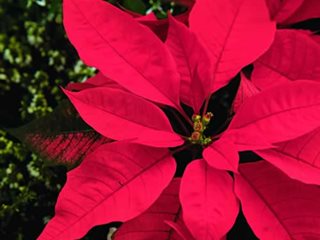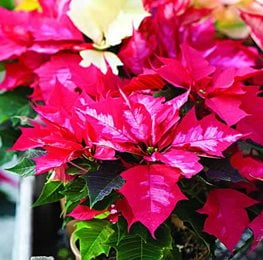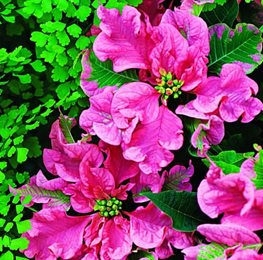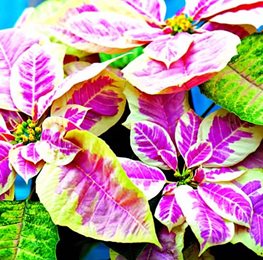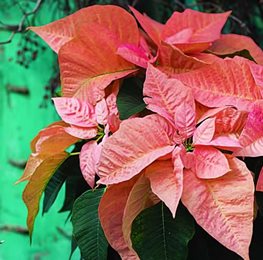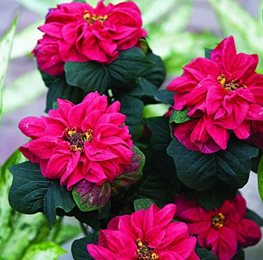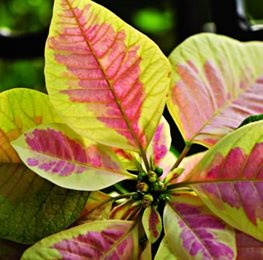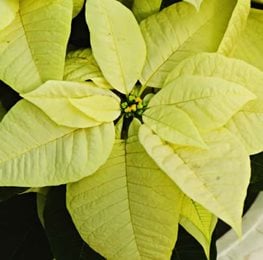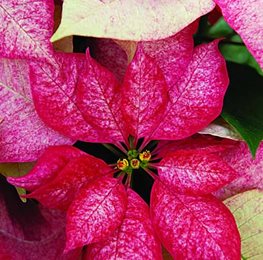How to Care for Poinsettias
Helpful hints and tips on poinsettia care, plus 8 unique and colorful varieties.Poinsettias have become as entwined with our Christmastime traditions as carols and mistletoe. And it’s no wonder. There’s something magical about these festive plants. Sparked by shortening days, they burst forth with dazzling color just as the world outside turns gray and cold. Right on cue, tiny topknots of poinsettia flowers jut from colorful tiny yellow pockets (called cyathia) while the bracts—actually modified leaves—take on colors that sing to you from across the room.
POINSETTIA CARE
Temperature and humidity: Poinsettias prefer temperatures between 65 and 75 degrees Fahrenheit. Avoid drastic temperature drops, cold drafts, and placing plants next to a cold window as this can cause leaves to wilt. Poinsettias are tropical natives and appreciate daily misting.
Light: When you purchase a poinsettia for the holidays, it’s primed and ready to perform and will keep on looking good for several weeks no matter where it’s displayed. To make your poinsettia last even longer, give it as much natural light as you can in midwinter; however, avoid placing directly in front of hot south-facing windows. Proper light, water, and warmth will help plants resist pests.
Soil: Average potting soil is fine if you’re repotting your poinsettia.
Water: Overwatering is a common killer. Water your poinsettia when the surface of the soil feels dry to the touch, but not every day. Remove any foil around the container to allow water to drain. Generally, watering once or twice a week will suffice if you moisten the soil thoroughly. Avoid wetting the foliage.
Fertilizer: Since poinsettias are blooming but not growing when purchased for the holidays, fertilizer isn’t necessary.
FREQUENTLY ASKED QUESTIONS
Are poinsettias poisonous? All parts of the poinsettia plant can cause mouth and stomach irritation if ingested, so keep the plants away from children and pets. The latex in poinsettias can cause a skin reaction in some people—play it safe and wear gloves when pruning or repotting. (For more, see "Holiday Plants with Toxic Misconceptions" from the National Library of Medicine.)
Can poinsettias be left out in the cold? Poinsettias can't handle frost and can be damaged or killed if temperatures go below 50 degrees, even for a limited time. That means getting a poinsettia home during the holidays can be dicey if you live in colder zones. Avoid leaving them in an unheated car, and protect it with a light covering when transporting it from store to car or car to home.
Can poinsettias be grown outdoors year-round? If you live in tropical Zones 10-12, the answer is yes. In their native setting, poinsettias are perennials and can grow to 10 feet tall. After enjoying your poinsettia for the holiday season, let the plant die back, prune to 4 to 6 inches, and place near a sunny window. Plant outside only after any chance of frost has passed. They prefer well-drained, slightly acidic soil and an area protected from harsh wind. Once green shoots appear, continue watering and fertilizing regularly during the growing season. Prevent leggy growth with regular trimming.
COMMON POINSETTIA VARIETIES
There are over 100 varieties of poinsettias, blooming in shades of red, pink, white, yellow, purple, and multicolored. Some of the more common varieties are:
- Prestige Red: Classic red, a best seller.
- Jingle Bells: Red bracts splashed with soft pink or white.
- Winter Rose Early Red: Smaller, curled, dark red bracts that resemble a rose bloom. Also available in white, pink, and marbled.
- Plum Pudding: The first poinsettia with purple bracts.
8 UNIQUE POINSETTIA VARIETIES
Poinsettias have come a long way from their Mexico-native species, Euphorbia pulcherrima. Decades ago, poinsettias (named for the nineteenth-century ambassador to Mexico Joel Poinsett) were bred to have broader and brighter leaves. But that was only the beginning.
Now there are many more forms to seduce us, with colorful bracts embellished by streaks, marbling, zigzags, speckles, and creamy hems; others with dramatically curled bracts; and still others that impress with their size, from huge specimens to itty-bitty pocket-size ones. And then there are the colors: deep crimson, flaming orange, peach, and many other hues. There’s nothing blah-humbug about poinsettias these days—they’ve entered a new age. Here are a few of the more unique varieties:
1. ‘Ice Punch’
Marbling is all the rage in poinsettias. On this version from Ecke Ranch, lightning streaks of white emblazon the heart of red, holly leaf-shaped bracts. “What is cool,” says Jack Williams of Ecke, “is that ‘Ice Punch’ looks like frost has landed on the bracts.” And this poinsettia keeps getting better; week to week the central streak is joined by more white.
2. ‘Carousel Pink’
Wavy, frilly, and frothy are all good descriptions for the salmon-pink bracts of this cultivar, from Syngenta Flowers. This poinsettia begins showing color in late November. Given their curliness, the bracts are a tad smaller than average. Carousel types branch beautifully to form a broad, strong plant that can be transported easily from the garden center without fear of damage.
3. ‘Winter Blush’
The latest example of the marble trend is ‘Winter Blush’. This Ecke variety was chosen for both its patterned foliage and the pronounced contrast between pink centers and cream etching on the margins. Bring it to friends and family as a holiday gift without fear—the strong stems withstand breakage.
4. ‘Cinnamon Star’
Although red is still king for poinsettias, holiday revelers are also excited by other shades. Syngenta Flowers is the mastermind behind this luminous coral-colored version. ‘Cinnamon Star’ boasts a rounded shape with expansive, almost winged bracts. The younger central bracts begin with a darker sizzle before fading paler with the countdown to the winter holidays.
5. ‘Winter Rose Early Red’
This novelty started the “nontraditional” streak at Ecke. For poinsettia breeders, the holy grail has been a flat-bracted, big red poinsettia. So it came as a welcome shock when a funky little version was the talk of the trials. Not only did ‘Winter Rose Early Red’ revolutionize the holiday container-plant market, it also made a splash with florists looking for a new spin on holiday décor.
6. ‘Mars Marble’
The earliest marbled poinsettias, pioneered in the 1970s, were almost all based on red. Now other colors have joined the party, notably Syngenta Flowers’ ‘Mars Marble’, with its soft, delicate pink, and equally demure milky cream colors on open-faced, smooth-edged bracts. This poinsettia starts to show color early, and the plant maintains a sturdy, upright posture.
7. ‘Whitestar’
Pink was the first non-red poinsettia color to become popular, but white was not far behind. Syngenta Flowers' ‘Whitestar’ has huge, smooth, flat bracts flaring out like doves from the central topknot of flowers. ‘Whitestar’ has a rounded habit, is generously branched, and will show color in time for Thanksgiving.
8. ‘Premium Picasso’
“Jingling” is the term breeders use to denote white speckling on poinsettia bracts. ‘Premium Picasso’ delivers an especially diffuse, seemingly airbrushed look. Against a pinkish-white background, cherry-red flecks spangle the bracts. Meanwhile, the outer bracts range from pure white to palest pink. The effect is a two-toned fantasia.
RELATED:
Growing Holly
Frankincense & The Magi's Endangered Tree
Last updated 12/10/2019
